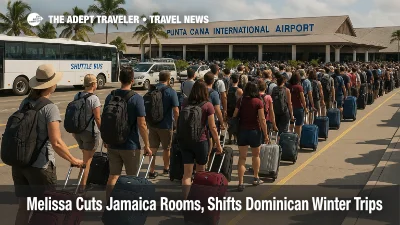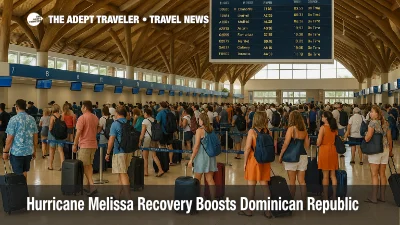Cuba

Embark on an unforgettable journey as you travel to Cuba, an island nation infused with pulsating rhythms and old-world charm. As you step onto its sun-kissed shores, take a deep breath and savor the intoxicating aroma of sea salt mingled with the rich, earthy scent of freshly rolled cigars, instantly whisking you into a realm where time seems to stand still. In the vibrant streets of Havana, the soulful strum of a guitar and the vibrant hum of conversation create a lively soundtrack, while vintage cars in a kaleidoscope of colors navigate the cobblestone roads, their polished chrome gleaming under the tropical sun. Delve deeper into Cuba’s allure with a taste of its culinary wonders, from the tangy zest of a mojito to the savory delight of ropa vieja, each bite telling a story as rich as the island’s history. As the fiery hues of a Cuban sunset paint the sky, allow yourself to be swept away by the island's enchanting mosaic of culture, music, and warmth, inspiring an irresistible urge to dive deeper into the mysteries and magic of Cuba. Let this be the start of your adventure as you explore the myriad possibilities that await when you travel to Cuba.
Cuba Travel Season
Travel to Cuba is a captivating experience where rich cultural heritage meets stunning natural landscapes. To make the most of it, understanding the best travel seasons can greatly enhance the experience. Cuba's peak season typically runs from mid-December to mid-April. During this time, the weather is incredibly favorable, with warm temperatures, low humidity, and very little rain. This coincides with the dry season, making it an ideal time for tourists to enjoy the sun-drenched beaches, historic architecture, and vibrant festivals.
However, traveling to Cuba during the peak season does come with its challenges. As this is the most popular time to travel to Cuba, the island witnesses an influx of visitors, leading to crowded attractions and higher prices for accommodation and flights. For travelers looking to enjoy milder crowds while still experiencing pleasant weather, visiting in the shoulder months of November and May presents a great opportunity. These months border the peak season, offering similar weather conditions with significantly smaller crowds and more competitive prices.
Off-Peak Travel Insights
Exploring Cuba during the off-peak season, primarily from June to October, offers an entirely different travel to Cuba experience. This period aligns with the wet season and hurricane season, bringing about frequent, albeit often brief, rain showers. While the humidity can be high, this season allows travelers to enjoy a more authentic Cuban experience, interacting with locals in a more relaxed setting. It's the perfect time for travelers looking to immerse themselves in the local culture without the typical tourist crowds.
During off-peak months, travel to Cuba also means benefiting from reduced prices on flights and accommodations. There are unique local events to enjoy, such as Fiesta del Caribe in July, which celebrates Caribbean culture with lively parades, music, and dance. Additionally, visiting during this time allows for a more flexible itinerary, as there’s often more room for spontaneous adventures and exploring off-the-beaten-path locations without long waits or reservations.
Seasonal Highlights and Local Celebrations
Each travel season in Cuba offers distinct highlights and local celebrations that contribute to a vibrant travel experience. Those visiting during the high season can look forward to events such as the Havana International Jazz Festival in January, which showcases world-class talent in Cuba's capital, or Santiago de Cuba's Carnival in July if traveling earlier in the year. These festivals are excellent opportunities to experience Cuba's rich musical heritage and lively atmosphere. Meanwhile, the Christmas and New Year holidays bring a festive spirit that permeates city streets and rural towns alike.
Part of the allure of planning travel to Cuba is aligning one's visit with these fascinating events and the beautiful scenery that each season promises. A well-planned itinerary that considers the various climates and tourist flow throughout the year will result in a rewarding and memorable journey through this unique Caribbean destination.
The Weather and Seasons in Cuba
The weather in Cuba offers a dynamic climate system that distinctly divides the year into two main seasons, making it an intriguing destination for travel enthusiasts. The tropical climate of Cuba ensures a warm environment throughout the year, with unique variations between the wet and dry seasons. Travelers can expect relatively consistent warm temperatures, which makes Cuba an attractive destination any time of the year.
Dry Season in Cuba
Travel to Cuba during its dry season, which extends from November to April, is particularly favorable for those who prefer less humidity and rainy days. During these months, temperatures remain comfortable, ranging from 70°F to 82°F (21°C to 28°C). The dry season is considered the peak travel season due to its pleasant weather, minimal rainfall, and vibrant local events. This is the perfect time for visitors to enjoy Cuba's beautiful beaches, explore its rich history in the cities like Havana, and partake in various outdoor activities without the interference of rain or humidity.
Rainy Season in Cuba
The Cuban rainy season, spanning from May to October, is marked by higher humidity and significant rainfall. Temperatures during this time are usually higher, ranging from 77°F to 89°F (25°C to 32°C), contributing to a more humid climate. July and August are typically the hottest months. Travel to Cuba during this time might involve encountering tropical rainstorms, which, although heavy, are usually brief. Despite the increased precipitation, this season also offers lush landscapes and is less crowded, providing travelers with a unique experience of Cuba's natural beauty.
Hurricane Season Considerations
While planning travel to Cuba, it is essential to consider the hurricane season, which coincides with the latter part of the rainy season, typically from June to November. Travelers should stay informed about weather updates and plan accordingly to ensure a safe and enjoyable trip. Hurricanes are more likely in September and October, so adequate preparations and flexibility are recommended for those visiting during these months.
Optimal Conditions for Traveling to Cuba
The best time for most travelers to visit Cuba is during the dry season when the weather is cooler, and the chances of rain are significantly lower. These months also coincide with numerous cultural festivals and events, providing an additional allure for travelers. Whether one is visiting the vibrant cityscapes of Havana, the historic town of Trinidad, or the pristine beaches of Varadero, the dry season offers optimal conditions for exploration and relaxation. However, those seeking a more tranquil experience may appreciate traveling during the off-peak rainy season, enjoying fewer tourists and lush scenery.
In any season, the charm of Cuba lies in its warm climate, rich cultural heritage, and the genuine warmth of its people, encouraging travelers to explore its diverse landscapes and fascinating history. Whether basking in the sun on its sandy shores or exploring its cobblestone streets, Cuba's weather ensures that it remains an ever-popular travel destination. Remember to pack accordingly to make the most of your travel to Cuba, ensuring comfort and flexibility throughout your stay.
Accepted Payment Methods and Other Payment Information in Cuba
When planning travel to Cuba, understanding the payment options available is crucial to ensure a smooth journey. The local currency in Cuba is the Cuban Peso (CUP), utilized by residents and increasingly accessible to tourists. It's important to note that, historically, the Cuban Convertible Peso (CUC) existed alongside the CUP, but the dual currency system has been abolished since 2021. Therefore, visitors to Cuba should acquaint themselves with the CUP for all transactions during their travel.
Traveling to Cuba with credit cards requires some preparation, as the acceptance of various card networks can vary greatly. Visa and Mastercard are fairly widely accepted in hotels, larger restaurants, and tourist-centric locations. However, travelers should be aware that American Express and Discover cards are generally not accepted at all in Cuba, due to longstanding U.S. restrictions. It's advisable to check your card issuer's policies concerning Cuba well in advance of your trip, ensuring your credit card can be utilized on the island.
Cash Usage
While credit card facilities are expanding, cash remains the principal method of conducting transactions for the majority of goods and services in Cuba. Travelers should bring enough cash to cover their trip expenses, as currency exchange and ATM withdrawals can sometimes be limited due to sporadic connectivity issues and machine availability. Tourists often exchange their money to Cuban Pesos at banks or official Cadeca exchange bureaus to ensure they receive the best rates and authenticity of the currency.
Tipping Etiquette
Tipping is a customary practice in Cuba, often representing a significant portion of income for those working in the service industry. It is generally expected to leave a tip of around 10% in restaurants if gratuity isn't included in the bill. Porters, taxi drivers, and hotel staff also greatly appreciate small tips. When planning travel to Cuba, including such tips in the budget can enhance the travel experience and support local workers.
Additional Payment Information
For travelers to Cuba, familiarity with local payment nuances can greatly enhance the experience. Prioritize acquiring small denomination Cuban Pesos to facilitate purchases, as making change for larger bills can sometimes be a challenge. Additionally, make sure to retain the receipt for any currency exchange transactions, as it may be needed if converting unused CUP back to another currency before departure. Understanding these facets of payment when traveling to Cuba can ensure that all financial dealings are handled smoothly, leaving more time to enjoy the richness and vibrancy of Cuban culture.
Why You Should Travel to Cuba
Cuba offers a captivating blend of history, culture, and natural allure, making it a must-visit destination for enthusiastic travelers. From vibrant cityscapes to tranquil beaches, the island nation presents a wealth of experiences waiting to be discovered.
Rich Cultural Heritage
Travel to Cuba for an immersive dive into its vibrant cultural tapestry. The fusion of indigenous, African, Spanish, and Caribbean influences is evident in Cuba's dance, music, and art. Visitors can explore traditional Afro-Cuban rhythms, iconic Cuban salsa, and rumba scenes thriving in the bustling streets and cultural centers.
Historic Architecture
Cuba is a treasure trove of architectural marvels. With cities like Havana and Trinidad offering a remarkable journey back in time, travelers can wander through cobblestone streets lined with colorful colonial buildings, grand squares, and jaw-dropping historic cathedrals. The well-preserved structures reflect Cuba's storied past, making it a photographer's paradise.
World-Famous Music Scene
Music is the heart and soul of Cuba, where melodies fill every corner of its cities. Visit authentic music venues in Havana, such as the renowned Buena Vista Social Club, to experience the pulsating rhythm of Cuban jazz, son, and trova, which form the soundtrack of life on the island.
Breathtaking Natural Landscapes
Cuba's diverse range of natural beauty is a stark contrast to its energetic cities. The lush tobacco fields of Viñales Valley, the Sierra Maestra mountains, and the unspoiled beaches of Varadero and Cayo Coco offer stunning vistas and outdoor adventure opportunities. Hiking, rock climbing, and bird watching are just a few activities through which travelers can engage with Cuba's exquisite landscapes.
Vibrant Local Markets and Handicrafts
Travel to Cuba to explore its lively local markets, where skilled artisans display an array of handmade goods. From intricate textiles to authentic Cuban cigars, these markets reveal the innovative spirit of the Cuban people. Delve into buzzing bazaars like Almacenes San José and immerse yourself in the local commerce and creativity.
Unique Culinary Journey
Cuban cuisine is a testament to the island’s cultural blend and historic influences. Savor a traditional meal of ropa vieja or indulge in street food favorites such as churros and empanadas. The culinary landscape is enhanced by paladares, private family-run restaurants offering uniquely personalized meals that reflect Cuba's innovative spirit.
Classic Cars and Nostalgic Atmosphere
Experience a blast from the past as you ride through Cuba's streets in a classic American car from the 1950s. This quintessentially Cuban tradition offers travelers a tangible sense of nostalgia and embodies the nation's resilient spirit. Photogenic cars abound, providing ample opportunities for uniquely Cuban snapshots.
Friendly and Welcoming Locals
Cubans are known for their warm hospitality, making a trip to the island both inviting and personable. While language barriers may exist, communication through heartwarming smiles and gestures is effortless. Travelers often leave with cherished memories and newfound friendships formed with locals eager to share their culture and stories.
Revolutionary History
History enthusiasts traveling to Cuba will find significant sites that offer insights into the country’s revolutionary past. Learn about Fidel Castro and Che Guevara's legacies at the Museum of the Revolution in Havana, or visit the Che Guevara Mausoleum in Santa Clara. These sites offer profound educational experiences for visitors seeking to understand Cuba's complex history.
Stunning Beaches and Maritime Adventures
Cuba boasts some of the Caribbean's most beautiful beaches, attracting travelers seeking sun, sand, and sea. Varadero, Guardalavaca, and Playa Paraiso are idyllic spots for relaxation, snorkeling, and scuba diving. The warm, clear waters teem with marine life, offering unforgettable adventures under the Cuban sun.
The History of Cuba
Cuba, with its rich tapestry of history, has long fascinated travelers from around the world. The island nation is steeped in centuries of history that date back to when the indigenous Taíno people first inhabited the land. European influence began with Christopher Columbus's arrival in 1492, marking the beginning of Spanish colonization. This era left a lasting legacy on the architecture, religion, and linguistic landscape that continues to draw those interested in exploring how the fusion of indigenous and European cultures created a unique identity. As you travel to Cuba, you'll be captivated not only by its beautiful landscapes but also by the deep historical stories etched into every corner of this island paradise.
The struggle for independence from Spanish rule is a pivotal chapter in Cuba's history, one that history enthusiasts find particularly compelling. The late 19th century was marked by a series of conflicts, including the Ten Years' War and the Cuban War of Independence, which eventually led to Cuba's emancipation, though it became a U.S. protectorate shortly afterward. The island's fight for autonomy adds layers to its identity as a defiant and resilient nation. Sites such as the Moncada Barracks, now a museum, offer tangible insights into these historic struggles. Travelers to Cuba will find the stories of famous figures like José Martí and the complex dynamics of the Spanish-American War richly preserved for exploration and learning.
In more recent history, Cuba underwent a significant transformation with the Cuban Revolution of 1959. The revolution led by Fidel Castro introduced sweeping social and economic changes that continue to influence Cuba's identity today. Travel to Cuba to experience a society shaped by a unique blend of socialist ideologies and cultural vibrancy. Havana's Revolution Square and the Che Guevara Mausoleum in Santa Clara stand as prominent landmarks reflecting these transformative years. For those drawn to history, these sites offer a narrative of revolutionary fervor and provide a backdrop to one of the most significant political shifts of the 20th century.
The cultural heritage of Cuba is as diverse as its history, offering a rich experience for those who travel here. From the pulsating rhythms of Son and Salsa music to the intricate flavors of Cuban cuisine, the nation's cultural tapestry is something to savor. Cities like Santiago de Cuba and Trinidad offer architectural wonders, historic sites, and vibrant festivals that celebrate Cuba's African, Spanish, and Caribbean roots. These experiences provide travelers with a deeper understanding and appreciation of the cultural forces that continue to define Cuba's identity on the world stage. As you plan your travel to Cuba, know that each corner of the country presents a chance to dive into history, witness living culture, and become part of its ongoing story.
The Culture of Cuba
The vibrant culture and warm-hearted people of Cuba are compelling reasons to travel to this fascinating Caribbean island. Embodying a mix of African, Spanish, and Caribbean influences, Cuba's cultural landscape is unique and dynamic. Its rich history is expressed in its lively festivals, compelling traditions, and passionate artistic expressions. Cuban traditions often revolve around music, dance, and communal gatherings, which are typically filled with rhythmic beats and synchronized movements, showcasing a zest for life that is irresistibly contagious. For travelers seeking an authentic experience, immersing in Cuba’s cultural scene offers a profound connection to its soul and identity.
Among its many celebrated traditions, Cuba’s festivals are a reflection of the country’s diversity and historical richness. The Cuban Carnival, especially those held in Santiago de Cuba and Havana, are vibrant spectacles of color, music, and dance, encapsulating the spirit and exuberance of the Cuban people. These carnivals are important events where locals and travelers alike can partake in parades, traditional music, and dancing. Similarly, religious festivals like "La Virgen de la Caridad del Cobre" are deeply rooted in Cuban history and offer a glimpse into the spiritual traditions that have been preserved over centuries. These events showcase the island’s ability to weave cultural influences into unique celebrations.
Daily customs in Cuba often emphasize communal living and hospitality. Family and social gatherings are central to Cuban life, where music and dance are never in short supply. Rumba, Son, and Salsa music, along with their accompanying dances, are not only performance art forms but are essential parts of social interaction. Music permeates every aspect of Cuban life, acting as a universal language that unites people across cultural lines. Art too forms part of these daily interactions, with streets lined with galleries and workshops showcasing the creative talents of Cuban artists. Travel to Cuba provides an opportunity to experience this deeply ingrained cultural appreciation that has been fostered through generations.
Cuba's multicultural heritage is further enriched by its diverse population, blending African, indigenous Taíno, and European elements to create a harmonious cultural mosaic. While the indigenous Taíno culture has largely disappeared, Cuba has made notable strides in preserving what remains, ensuring these ancient influences continue to inform cultural practices. The integration of African cultural elements is particularly evident in the island’s music and dance, where African rhythms meld seamlessly with Spanish melodies to create new, distinctly Cuban forms. Travel to Cuba invites an exploration of this cultural synergy, offering travelers rich, diverse experiences that underscore the island’s historical and cultural evolution.
The Culinary Experience of Cuba
When you travel to Cuba, you're in for a culinary adventure that mirrors the island's rich cultural tapestry. Cuban cuisine is a distinct blend of Spanish, African, and indigenous flavors, enriched over centuries by Caribbean influences. Travelers will be enchanted by the island's culinary offerings, from hearty stews to light, citrusy salads. A visit to Cuba reveals the local love for rice and beans, a staple combination often served with succulent pork or chicken. Traditional dishes such as Ropa Vieja, a savory shredded beef stew, and Picadillo, a spiced ground beef dish, reflect the hearty and communal nature of Cuban dining. The ubiquitous presence of plantains, prepared in various ways like tostones and maduros, adds a deliciously golden touch to many meals.
No travel to Cuba would be complete without trying its exceptional street food, unique for its simplicity and incredible taste. As you stroll through the vibrant streets, you'll encounter vendors selling everything from fresh coconuts to churros sprinkled with sugar. The quintessential Cuban sandwich, made with roasted pork, ham, Swiss cheese, pickles, and mustard, pressed in a panini-style hot grill, is a local favorite that perfectly epitomizes Cuban street eating. For a snack with a twist, Cuban tamales, filled with a mix of seasoned meat and cornmeal, offer an excellent option. Additionally, the island is renowned for its seafood, with ceviche and grilled fish available at numerous coastal markets and restaurants.
Cuba’s homemade beverages are a testimony to its vibrant cultural scene. The island's rum tradition is legendary, and travelers will find a variety of cocktails that showcase this spirit's versatility. Mojitos, Cuba Libres, and Daiquiris are universally famous, but indulging in a taste of local rums like Havana Club or Santiago de Cuba is a must. Beer lovers should sample Cristal and Bucanero, popular local brews known for their refreshing qualities. Also worth exploring is the island's lesser-known wine culture, with some Cuban vineyards producing a range of interesting wines. You'll also find unique non-alcoholic options, such as Guarapo, a refreshing juice made from sugarcane, which is both a treat and a reflection of Cuba's agricultural bounty.
As you travel to Cuba, don't miss out on the exceptional dining experiences that are interwoven with the island's cultural fabric. Havana hosts paladares, privately-owned restaurants serving authentic Cuban fare in intimate settings, offering a more personalized and cozy dining experience. These establishments bring the essence of Cuba’s home-cooked meals to the forefront. For those with specific dietary needs, options are steadily increasing. While traditionally meat-heavy, Cuban cuisine has adapted to include more vegetarian and vegan dishes. Seasonal specialties can be found at the bustling food markets, including the popular Napoleón Valdés Rodríguez produce market. Those seeking to fully immerse themselves should attend events like the annual Cuban Food Festival, which celebrates the island's gastronomy with cooking demos and tastings, providing an insight into Cuba's culinary traditions and future.
What to See and Do in Cuba
Cuba, a gem in the Caribbean, offers travelers a rich tapestry of experiences, from its sun-kissed beaches to its vibrant cultural scene. Travel to Cuba provides a journey through a nation that offers diverse adventures and memorable moments for every kind of traveler.
Stroll Down the Historic Streets of Havana
Travel to Cuba demands a visit to Havana, especially the delightful walk through its historic streets. Old Havana, or Habana Vieja, is a UNESCO World Heritage Site that captures the heart of Cuban history. The cobblestone streets lined with colorful colonial buildings give off an unmistakable charm. Every corner invites you to explore art galleries, listen to live music spilling from cafes or sip on a refreshing mojito. Solo travelers will find endless photo opportunities, while families can enjoy hands-on history lessons with each step.
Feel the Rhythm in Trinidad
Experience Cuba by diving into the rhythms of Trinidad, a colonial town bursting with music and life. Known for its beautifully-preserved Spanish architecture and cobblestone streets, Trinidad feels like a journey back in time. By day, explore churches and museums, or wander into markets filled with local artisans. As night falls, salsa spills into the streets, inviting you to dance alongside locals and travelers alike. Adventure seekers looking to engage with local culture will find Trinidad to be an unmissable spot in their travels to Cuba.
Relax on the Unspoiled Beaches of Varadero
Cuba's reputation for stunning beaches is exemplified by Varadero, a gorgeous stretch of white sand meeting the azure Caribbean Sea. Varadero offers both relaxation and adventure, perfect for families and couples seeking sunshine, swimming, and water sports. Snorkeling and scuba diving reveal vibrant coral reefs and marine life, while the beach itself provides ample opportunities for sunbathing or leisurely strolls. This paradise makes it easy to forget the hustle of daily life, capturing the essence of travel to Cuba.
Explore the Wilderness in Viñales Valley
For a scenic escape into nature, the Viñales Valley is essential for any travel to Cuba itinerary. This striking region is marked by lush tobacco fields and dramatic limestone formations known as mogotes. Outdoor enthusiasts can explore the area’s numerous hiking and cycling trails, or take a guided horseback riding adventure through the valley. This UNESCO World Heritage Site is perfect for travelers seeking tranquility and natural beauty, offering an idyllic picture of rural Cuba.
Marvel at Havana's Malecón
The Malecón, Havana's famous seafront avenue, is a vibrant place where traditional Havana meets the new. A walk along the Malecón provides breathtaking views of the city on one side and the vast expanse of the ocean on the other. By day, it's a relaxing spot to observe fishermen or explore the historic architecture lining the boulevard. At night, it transforms into a lively gathering place where locals and tourists come to enjoy the ocean breeze and dynamic social atmosphere. Whether you’re a solo traveler or part of a group, the Malecón is an iconic aspect of travel to Cuba.
Venture into the Sierra Maestra Mountains
Adventure seekers traveling to Cuba will cherish a trek through the Sierra Maestra Mountains. Known as the heart of Cuba's revolutionary history, these mountains offer challenging hikes and rewarding vistas. Explore the lush landscapes that were once the hideout of Fidel Castro and his rebels, with trails offering various difficulty levels to suit different fitness standards. The region is ideal for those wanting to connect with nature, history, and the indomitable spirit of Cuba.
Visit the Historic Bay of Pigs
History buffs will find their curiosity piqued at the Bay of Pigs, site of the failed invasion attempt in 1961. Located on the southern coast, this region also offers beautiful beaches and some of the finest diving spots in Cuba. Whether you’re interested in the intriguing history or the rich marine life, the Bay of Pigs is a rewarding stop on any travel to Cuba trip. Underwater caves, vibrant coral reefs, and historic landmarks make this destination exciting for families and individual travelers alike.
Delight in the Flavors at a Paladar
No trip to Cuba is complete without experiencing the diverse local cuisine. Paladares, privately run restaurants often set up in family homes, provide an intimate dining experience with authentic Cuban food. Indulge in dishes like ropa vieja, succulent grilled lobster, or classic Cuban desserts. This culinary experience offers a delicious way for travelers to engage with Cuba’s flavorful culture and enjoy the warmth of its people.
Discover the Artistic Allure of Fusterlandia
Art lovers traveling to Cuba should not miss Fusterlandia, the whimsical work of artist José Fuster. Located in the neighborhood of Jaimanitas, this artistic wonderland is a mosaic-covered spectacle. Vibrant tiles cover everything from houses to benches, creating a fantastical landscape reminiscent of Gaudí’s work in Barcelona. Children and adults alike will find charm and inspiration in this colorful spectacle, a testament to Cuba’s vibrant art scene.
Engage with the Endangered at Zapata Swamp
The Zapata Swamp is a must-visit for nature enthusiasts and bird watchers traveling to Cuba. This vast wetland is home to a wealth of wildlife, including many rare and endangered species. Experience guided tours that delve into the rich biodiversity of the area, where travelers can observe the Cuban crocodile and vibrant bird species in their natural habitat. Zapata Swamp offers a unique perspective on Cuba’s natural world, providing an adventurous escape into the country’s lush ecosystems.
Tips & Tricks for Traveling in Cuba
Exploring Havana’s Hidden Gems
When you travel to Cuba, especially its capital Havana, don’t just stick to the tourist hotspots like Old Havana and the Malecón. While these are must-sees, consider taking a stroll through less frequented neighborhoods like Vedado or Centro Habana. Here, you can interact with locals and discover quaint cafes, vintage shops, and beautiful street art. The authentic Cuban culture thrives off the beaten path and gives a truer sense of the present-day lifestyle beyond the well-trodden routes.
Mastering Local Transport: The Almendrón Experience
Cuba has a unique form of public transport known as almendrones, old American cars that function as shared taxis. When you travel to Cuba, embracing this mode of transport can save you money while offering a quintessential Cuban experience. Check the route beforehand, as they follow fixed paths, and prepare to share your ride with locals. A basic Spanish vocabulary can be handy since drivers may not speak English. Whether alone or with friends, this option offers an immersive sense of the vibrant, bustling life in Cuba.
Respecting Local Customs and Etiquette
Understanding and respecting Cuban customs will enrich your travels. When addressing Cubans, the formality of titles is appreciated; use Señor or Señora followed by surnames. Cubans are known for their warmth and friendliness, so being polite can forge positive interactions. It's customary to greet people with a handshake or a kiss on the cheek. Providing tips, even small ones, in restaurants and for services is welcomed and shows appreciation. These gestures go a long way in ensuring a warm reception during your stay in Cuba.
Budgeting Wisely with Dual Currencies
Another key aspect of travel to Cuba involves navigating its dual currency system: the Cuban Peso (CUP) and the Cuban Convertible Peso (CUC), though recent reforms are phasing out the CUC. Be sure to carry cash, as credit cards often aren't accepted, and ATMs are scarce. Use CUP for local goods and services for the best value. Before your trip, check the latest updates on the currency situation to ensure you're prepared for any changes. This strategy helps in effectively managing your travel budget in Cuba.
Timing Your Visits to Avoid Crowds
The peak tourist season in Cuba spans from December to May, which means more crowds at popular destinations and higher accommodation prices. For a more relaxed experience, consider visiting during the shoulder months like June or November. The weather is typically pleasant, and you'll find shorter lines at attractions and fewer tourists at beaches. This approach not only allows you to experience Cuba more serenely but often comes with cost savings on accommodation and tours.
Staying in Casas Particulares
For an authentic Cuban experience, opt to stay in casas particulares instead of hotels. These privately owned bed-and-breakfast-style homes offer an intimate glimpse into Cuban life. Often more affordable than hotels, these accommodations also contribute directly to the local economy. Additionally, your hosts can provide insider tips on visiting sights, dining, and exploring in their locality. This option is particularly beneficial for solo travelers looking for local insights and camaraderie.
Savoring the Cuban Cuisine
To truly experience Cuba, indulge in its culinary offerings. While renowned for its pork dishes and black beans, Cuban cuisine is influenced by Spanish, African, and Caribbean flavors. Seek out paladares, family-run restaurants, for dishes like ropa vieja or picadillo. Vegetarian options are limited, so if you have dietary restrictions, it’s smart to research menus beforehand. Tasting local flavors shouldn't be rushed; it’s an integral part of understanding Cuba’s rich cultural tapestry.
Exploring Beyond Havana
Many travelers stick to Havana, but Cuba's appeal extends well beyond its capital. Consider excursions to Trinidad, a UNESCO World Heritage site known for its colonial architecture and cobbled streets, or Viñales, famous for its tobacco fields and stunning limestone mountains. Such destinations offer vastly different experiences and are ideal for those interested in history, nature, and photography. Plan your itinerary to include various cities and regions to appreciate the full spectrum of what Cuba has to offer.
Language Learning: Making a Connection
Though you can navigate Cuba with limited Spanish, learning basic phrases enhances your travel experience significantly. Cubans are warm and appreciative of any effort to speak their language, and knowing simple pleasantries can lead to more meaningful interactions. Consider carrying a pocket phrasebook or downloading a translation app for quick look-ups. Engaging with locals through their language can provide deeper insights into Cuba's culture and way of life.
Capturing Cuba through Photography
Cuba is a photographer's paradise with its vibrant colors, vintage cars, and dynamic street life. Plan early morning or late afternoon shoots to capture the soft, golden light that enhances the scenery's natural allure. Always ask for permission before taking close-ups of Cubans, as respectful interaction should come before the lens. Explore both urban landscapes and rural charm to capture the full diversity of Cuba’s visual culture. Special precautions should be taken to protect your gear from the coastal humidity and sudden weather changes.
What To Know Before You Go to Cuba
Planning a travel adventure to Cuba can be an enriching experience filled with vibrant culture, historical charm, and breathtaking landscapes. To make the most out of your travel to Cuba, it's essential to understand certain key aspects before embarking on your journey.
Entry Requirements
When you travel to Cuba, it's essential to know the entry requirements. Most travelers need a tourist visa, also known as a 'tourist card,' which can typically be obtained through airlines, travel agencies, or Cuban consulates. Ensure your passport is valid for at least six months from your date of entry. It's advisable to check for any recent changes in visa policies before traveling.
Local Customs and Etiquette
Cuban culture is warm and welcoming, but understanding local customs and etiquette can greatly enhance your travel experience. When greeting locals, a friendly handshake or a simple hug is customary. Cubans appreciate when visitors show an interest in their culture, so trying a few words in Spanish is always welcomed. Dress codes are fairly casual, but modesty is appreciated, especially in more rural areas or religious sites.
Transportation Options
While public transportation in Cuba can be somewhat unreliable, there are several options for getting around. Classic American cars operate as collective taxis ('almendrones') and are a popular choice. Consider renting a car for more flexibility, but be aware that roads can be poorly marked and navigation is not always straightforward. Buses such as the 'Viazul' are a comfortable option for longer distances between cities.
Tipping Culture
Tipping is a customary practice in Cuba and is generally appreciated as local wages can be low. In restaurants, a tip of around 10% is common. For hotel staff, a small tip can also be given, and for taxi services, rounding up the fare is appreciated. Always check your bill to ensure service charges are not already included.
Health Precautions
Before traveling, consider health precautions necessary for Cuba. No mandatory vaccinations are required, but routine vaccinations and a Hepatitis A vaccine are recommended. It's a good idea to have travel insurance, as medical facilities can request upfront payment, and quality can vary in different regions.
Communication Tips
The official language in Cuba is Spanish, and while some Cubans speak English, especially in tourist areas, it's beneficial to know common phrases to enrich your interaction. Familiarize yourself with words and phrases such as "hola" (hello), "gracias" (thank you), and "¿cuánto cuesta?" (how much does it cost?). Bringing a Spanish phrasebook or a translation app can be incredibly helpful for non-native speakers.
By understanding these key factors, your travel to Cuba can be a more seamless and rewarding experience, allowing you to fully immerse yourself in the island's unique culture and natural beauty.
Accessibility in Cuba
Travel to Cuba presents a unique experience with its vibrant culture and rich history, but it's essential to understand the accessibility options available for travelers with various needs. Traveling in Cuba can pose some challenges for those with mobility impairments, although there are ongoing efforts to improve accessibility standards across the island. For individuals with limited mobility or who use wheelchairs, it is critical to plan ahead and be aware of the infrastructure and facilities currently in place.
Physical Accessibility in Cuba
When considering travel to Cuba, it is essential to note the physical accessibility accommodations for those with mobility issues. While Cuba has made strides in enhancing access for people with disabilities, much of its infrastructure remains challenging. Sidewalks in many areas can be uneven, and historic buildings often lack ramps or elevators. However, some progress has been made in urban centers like Havana, where newer hotels include features like elevators and ramps to improve accessibility.
Accommodations for Visual and Auditory Impairments
Travelers to Cuba who require visual or auditory accommodations might find limited resources compared to other destinations. In major cities, some public spaces and institutions offer support for visually impaired individuals, such as Braille signs or audio guides, although these are not widespread. For those who are deaf or hard of hearing, bringing a travel companion who knows sign language or a communication device can be advantageous, as specialized services are rare.
Accessible Transportation in Cuba
Public transportation in Cuba, including buses and trains, is not uniformly accessible by international standards. However, adaptations have been made in some newer buses within Havana, which feature low floors and designated spaces for wheelchairs. Given the inconsistency in available options, planning itineraries that rely heavily on taxis or private transportation can be a practical choice for travelers with mobility challenges. Taxi services can often provide accessible vehicles upon request, although advance arrangements are recommended.
Accessible Accommodations
While planning travel to Cuba, selecting accessible accommodations is crucial. Some hotels, particularly new or recently renovated ones in larger cities and tourist-friendly areas, offer rooms equipped with features like roll-in showers, elevators, and wider doorways. Nevertheless, these features are not prevalent in more rural or less-developed areas. Contacting hotels directly to confirm the availability of such features can help prevent unpleasant surprises.
Tourist Attractions
Exploring Cuba's cultural and natural attractions can be a highlight of any visit. Accessible attractions include locations such as parts of Old Havana, which have undergone renovation efforts to include ramp access and smoother pathways. Some museums and cultural sites have worked to improve access for visitors with disabilities. However, more remote attractions like national parks or beaches often lack comprehensive accessibility features, which travelers should consider when planning excursions.
Travelers with specific accessibility needs embarking on a journey to Cuba should prepare thoroughly and set realistic expectations. While Cuba continues to evolve and strives to be more inclusive, current facilities may not fully meet the requirements of all visitors. Nonetheless, with the right preparation, travelers with varying needs can enjoy exploring the unique settings and cultures that Cuba has to offer.
Health & Safety in Cuba
When planning to travel to Cuba, it's essential to consider various safety aspects to ensure a smooth and secure journey. From navigating local environments to understanding potential risks, being well-informed is key to an enjoyable experience in Cuba.
Water Safety
Travelers to Cuba should be cautious with local water sources as the quality may not meet international standards. It's advisable to drink bottled or purified water and to use the same water for brushing teeth. Avoid consuming ice as it may not be filtered. Travelers should also be cautious when consuming food from street vendors and opt for well-cooked meals to minimize the risk of waterborne diseases.
Natural Disaster Risks
Cuba is located in a region that can be subject to natural disasters such as hurricanes, especially from June to November. It's crucial to stay informed about weather conditions and any warnings issued by local authorities. Travelers should have an emergency plan in place and keep abreast of temporary closures or evacuations that may occur during these periods.
Crime
While Cuba is generally considered a safe country for tourists, there are instances of petty crime such as pickpocketing and theft, especially in crowded areas and tourist hotspots. To reduce the risk, travelers are encouraged to keep their belongings secure, avoid wearing flashy jewelry, and be vigilant in public spaces. Using credit cards safely and carrying limited cash are also recommended practices when visiting Cuba.
Political or Social Unrest
While major political or social unrest is not common in Cuba, there can be occasional protests or demonstrations. Travelers should avoid participating in or getting too close to any such events. Additionally, it's beneficial to stay informed about local news and advisories from the embassy regarding any developments that might affect travel plans.
Health and Safety Precautions
Healthcare services in Cuba are available but may differ in quality compared to other countries. It's advisable for travelers to have comprehensive travel insurance that covers medical evacuations. Visitors should also check for any specific vaccination requirements before traveling to Cuba. Common precautions include vaccines for Hepatitis A and B, Typhoid, and routine vaccinations. Carrying a basic medical kit can be beneficial, as some medications may not be readily available in Cuba.
Other Places You Might Like
Havana, Cuba - If you love the vibrant atmosphere of Cuba, exploring cities with rich culture and arts should be your next destination. Barcelona, Spain is a place where the energy of the city and its historical architecture, like the famous Sagrada Família and the bustling Las Ramblas, create a unique blend that rivals the charm of Havana. Whether you’re admiring the influential works of Gaudí or enjoying the lively night scene, Barcelona offers a dynamic experience similar to the spirited life found when you travel to Cuba.
Mérida, Mexico - Those fascinated by Cuban colonial architecture and historical charm will appreciate Mérida. This Yucatán Peninsula gem exudes historical opulence with its splendid colonial buildings and lively plazas reminiscent of Old Havana. Mérida bursts with a vibrant culture, evident in its traditional festivals and frequent street performances, offering a taste of Cuban warmth and hospitality. The culinary scene is just as compelling, tempting travelers with mouth-watering cuisine comparable to the authentic flavors you’d find when you travel to Cuba.
Cartagena, Colombia - Enveloped by colorful colonial streets and the Caribbean Sea, Cartagena outshines with a historical allure that echoes Cuba. The city’s old town, a UNESCO World Heritage site, is a vivid tapestry of cobblestone lanes, grand churches, and vibrant festivals, much like the nostalgic charisma of Trinidad. Its pristine beaches and nearby natural wonders enhance the tropical vibe, offering a blend of heritage and relaxation that Cuba aficionados would find irresistible.
Havana, Cuba - The Afro-Latin cultural fusion that permeates Cuba finds a parallel in Salvador, Brazil. Known for its Afro-Brazilian culture, Salvador vibrates with lively music, dance, and expressive art forms that captivate its visitors. The city’s historic Pelourinho district offers a sensory experience of rhythmic drumbeats and colorful colonial architecture, resonating with the lively dynamic familiar to those who travel to Cuba. A visit immerses you in a cultural vibrancy that feels both foreign and familiar.
Port Louis, Mauritius - For those who appreciate Cuba’s tropical appeal, Port Louis offers lush landscapes, scintillating beaches, and a multicultural heritage that mirror Cuban diversity. The bustling central market, botanical gardens, and the vibrant Sega dance performances are all reminiscent of the spirited Cuban vibe, drawing parallels with the country’s cultural diversity and natural beauty, enchanting travelers seeking an intriguing combination of relaxation and cultural exploration akin to what one experiences when traveling to Cuba.
Final Thoughts
Embarking on a journey to Cuba is more than just travel; it's an immersion into a world where time seems to have paused, capturing the vibrancy and spirit of a unique culture. The allure of Cuba is irresistible for those yearning for rich history, stunning landscapes, and a lively atmosphere that pulses through its cities and countryside alike. From the colorful streets of Havana, where classic cars and colonial architecture paint a picture of a bygone era, to the pristine beaches of Varadero and the lush valleys of Viñales, Cuba offers a diverse tapestry of experiences that cater to every traveler's passion and curiosity.
As you travel to Cuba, be prepared to engage with a culture that is as welcoming as it is intriguing. Whether it's through the passionate rhythms of salsa that fill the air, or the delicious aroma of traditional Cuban cuisine, your senses will be joyfully awakened by the authentic experiences that Cuba generously offers. The spirit of resilience and creativity is palpable, inviting travelers to dive deep into the local artistry, explore historic landmarks, and connect with the warm, hospitable locals who make every visit unforgettable.
Considering your next travel adventure? Cuba beckons as a must-visit destination, an idyllic blend of natural beauty, cultural richness, and historical intrigue. Let the enchanting island of Cuba captivate your heart and inspire your wanderlust. As you plan to travel to Cuba, anticipate an adventure that will not only fulfill your thirst for exploration but also enrich your life with memories and stories that echo its vibrant essence. Cuba is waiting—what are you waiting for?
Havana, Cuba

Holguín, Cuba

Santiago de Cuba, Cuba

Venezuela Airspace Warning Disrupts Caribbean Routes

Venezuela Airspace Warning Forces Flight Reroutes

Chikungunya Alerts For Cuba, Bangladesh, Sri Lanka, China

Venezuela Airspace Warning Reroutes Caribbean Flights

2028 World Cruise From Miami To Athens With Azamara

Cuba Blackout Disrupts Havana Hotels And Winter Trips

Melissa Cuts Jamaica Rooms, Shifts Dominican Winter Trips

Hurricane Melissa Recovery Boosts Dominican Republic Flights

Cuba Blackouts And Melissa Damage Hit Tourism

U.S.-Cuba Flights Tighten as Delta Cuts, United Exits

Hurricane Melissa: Cuba Airports, Power, and Travel

Cuba Next: Hurricane Warnings, What Travelers Should Do

Hurricane Melissa, Track And Travel Impact This Week

Melissa Intensifies, Waivers Issued for Jamaica, Hispaniola

Caribbean disturbance could become Tropical Storm Melissa

Caribbean tropical disturbance may alter late-week cruises

Royalton debuts Royalton Suites & Villas for Diamond Club

Chikungunya in the Caribbean: What travelers should know

Hurricane Gabrielle brings dangerous surf; Narda turns away

Cuban Electrical Grid Collapse Triggers Island-Wide Blackout

Tropical Storm Fernand swells near Bermuda, East Coast

Caribbean travel demand surges, Aruba, D.R., Jamaica lead

Cat-5 Hurricane Erin drives SXM, USVI cancellations

Tropical Storm Erin Forecast: Insurance Clock, Swell Risks

Blue Diamond Becomes Royalton Hotels & Resorts

